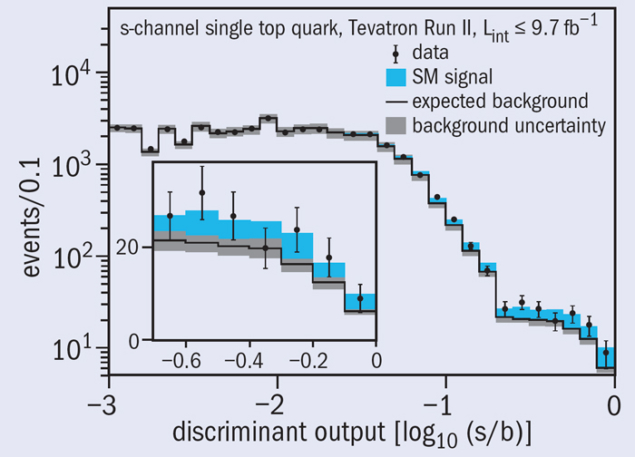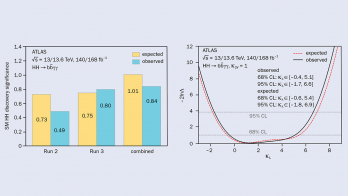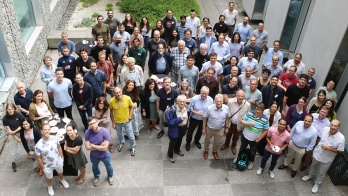
Data from the CDF and D0 experiments at the Tevatron have revealed one of the rarest methods of producing a top quark. The two collaborations announced jointly on 21 February that they have observed s-channel production of single top quarks.
The top quark, t, which was discovered in proton–antiproton collisions at the Tevatron in 1995, is the heaviest elementary particle of the Standard Model, with a mass of 173 GeV. Only the Tevatron and the LHC colliders have so far been capable of making t quarks. In s-channel production, a quark from a proton and an antiquark from an antiproton create a W boson, which decays to a t quark and a b quark. The t quark in turn decays to a new W boson and a b, leading to a final state of Wbb. The production of single t quarks in the s-channel is among the rarest decays of the W boson, given that one of the final state particles (t) has a rest mass more than twice that of the parent W boson.
Selecting a region of high signal-to-background, as shown in the figure, required the development of sophisticated analysis methods. These included identifying jets from the hadronization of the b quarks efficiently and with low background. Between them, the CDF and D0 collaborations analysed more than 2 × 1010 events recorded to tape during operation of the Tevatron as a collider between 2001 and 2011.
Each experiment saw a substantial excess of events – about 40 in total – that could be attributed to single s-channel production of the t quark (CDF 2014 and D0 2013). However, only by combining the results from both experiments to make full use of the Tevatron data set, could the teams push the significance of the observation to 6.3σ, consistent with the discovery of a new process (CDF and D0 2014). The measured production cross-section in the s-channel of 1.29 pb agrees with the Standard Model prediction and so excludes the possibility of a particle other than the W boson, not predicted by the Standard Model, as a source of single t quarks.
Detection of this extremely rare process was one of the final goals of the Tevatron programme to be achieved. However, it is not the end of the story for the top quark because many more studies will continue, both with Tevatron data and at the LHC, to understand fully the heaviest known elementary particle.
Further reading
CDF and D0 collaborations 2014 arXiv:1402.5126 [hep-ex], submitted to Phys. Rev. Lett.
CDF collaboration 2014a arXiv:1402.0484 [hep-ex], submitted to Phys. Rev. Lett.
CDF collaboration 2014b arXiv:1402.3756 [hep-ex], submitted to Phys. Rev. Lett.
D0 collaboration 2013 Phys. Lett. B 726 656.








